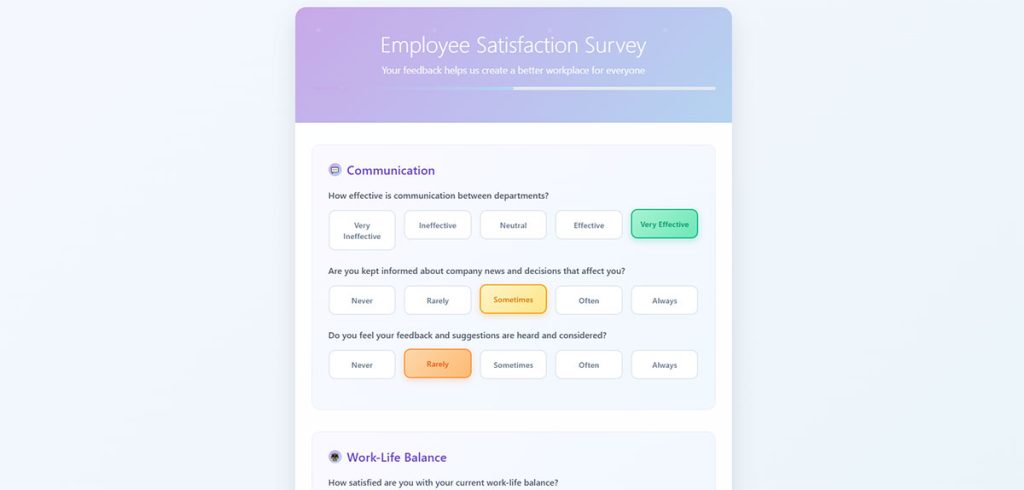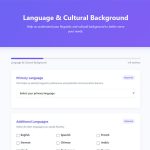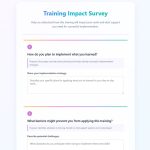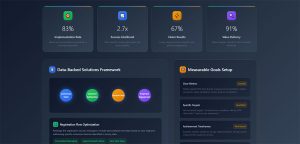You send a survey. Half your audience ignores it. The other half quits halfway through. Sound familiar? Survey fatigue is killing your response rates and destroying data quality. When participants…
Table of Contents
Employee satisfaction drives company success, yet many organizations struggle to measure workplace morale effectively.
Creating meaningful employee satisfaction survey questions helps uncover what truly matters to your workforce. The right survey methodology captures authentic employee feedback while addressing critical workplace satisfaction indicators.
With turnover costs reaching record highs, understanding job satisfaction factors becomes essential for retention. Organizations must move beyond generic questionnaires to develop targeted assessments that reveal:
- Workplace culture strengths and gaps
- Employee engagement levels across departments
- Career development opportunities
- Management effectiveness
This guide presents proven question templates, survey design principles, and implementation strategies. You’ll discover how to craft questions that generate actionable insights for improving employee experience and organizational commitment.
Employee Satisfaction Survey Questions
Overall Job Satisfaction
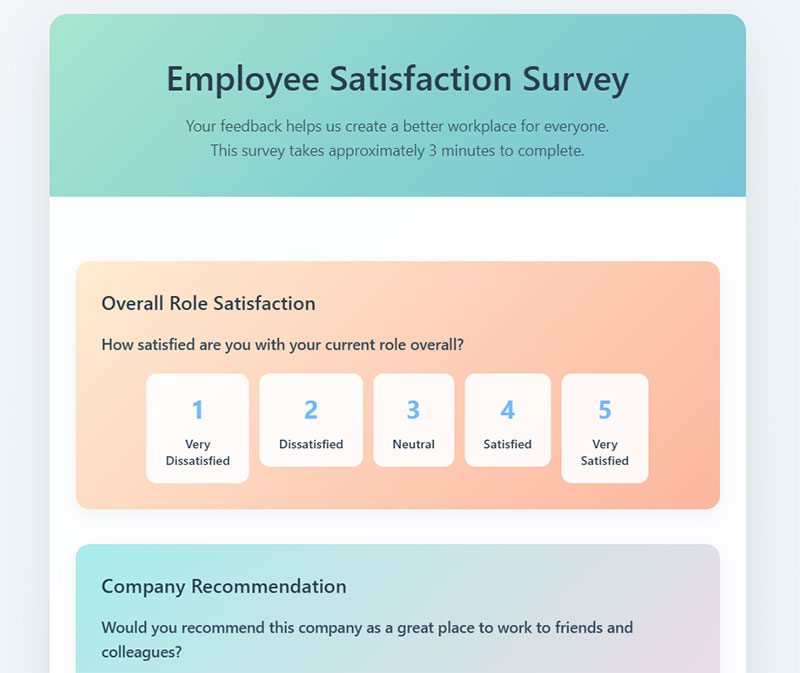
Overall Role Satisfaction
Question: How satisfied are you with your current role overall?
Type: Multiple Choice (1–5 scale from “Very Dissatisfied” to “Very Satisfied”)
Purpose: Provides a comprehensive baseline measure of employee contentment and serves as a key metric for organizational health.
When to Ask: In annual or bi-annual surveys as a primary indicator of workforce satisfaction.
Company Recommendation
Question: Would you recommend this company as a great place to work to friends and colleagues?
Type: Multiple Choice (1–10 scale from “Not at all likely” to “Extremely likely”)
Purpose: Measures employee advocacy and genuine satisfaction, similar to Net Promoter Score methodology.
When to Ask: Quarterly or annually to track reputation and employee loyalty trends.
Retention Likelihood
Question: How likely are you to still be working here in one year?
Type: Multiple Choice (1–5 scale from “Very Unlikely” to “Very Likely”)
Purpose: Identifies flight risk and helps predict turnover rates for workforce planning.
When to Ask: During annual reviews or when retention concerns arise in specific departments.
Work Environment & Culture

Psychological Safety
Question: Do you feel comfortable expressing your opinions and ideas at work?
Type: Multiple Choice (1–5 scale from “Never” to “Always”)
Purpose: Assesses psychological safety and openness in the workplace culture.
When to Ask: After organizational changes or when implementing new communication initiatives.
Cultural Alignment
Question: Does the company culture align with your personal values?
Type: Multiple Choice (1–5 scale from “Not at all” to “Completely”)
Purpose: Evaluates cultural fit and identifies potential sources of employee disengagement.
When to Ask: During onboarding follow-ups and annual culture assessments.
Team Collaboration
Question: How well does your team collaborate and support each other?
Type: Multiple Choice (1–5 scale from “Very Poorly” to “Very Well”)
Purpose: Measures team dynamics and identifies opportunities for improving collaboration.
When to Ask: Quarterly or after team restructuring to monitor group effectiveness.
Workplace Respect
Question: Do you feel respected and valued by your colleagues?
Type: Multiple Choice (1–5 scale from “Never” to “Always”)
Purpose: Assesses interpersonal relationships and workplace civility.
When to Ask: During diversity and inclusion surveys or after workplace conflict resolution.
Management & Leadership
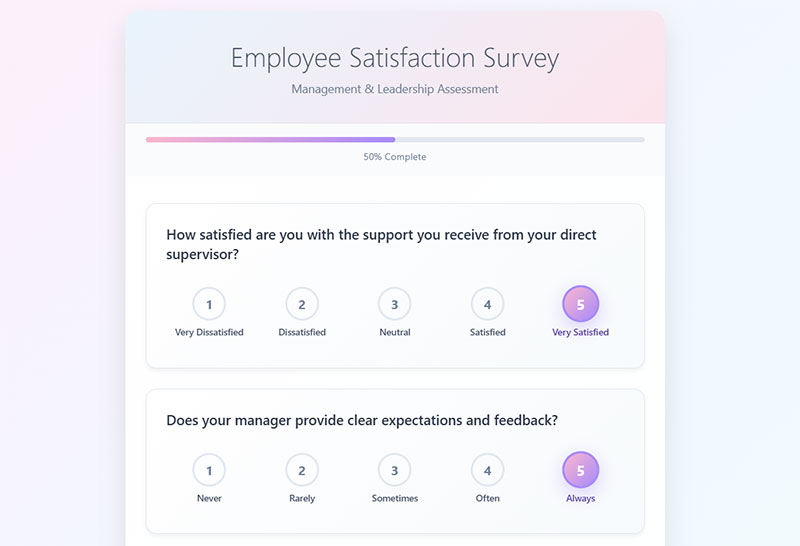
Supervisor Support
Question: How satisfied are you with the support you receive from your direct supervisor?
Type: Multiple Choice (1–5 scale from “Very Dissatisfied” to “Very Satisfied”)
Purpose: Evaluates direct management effectiveness and identifies coaching needs.
When to Ask: During performance review cycles or management training assessments.
Clear Expectations
Question: Does your manager provide clear expectations and feedback?
Type: Multiple Choice (1–5 scale from “Never” to “Always”)
Purpose: Measures communication clarity and management effectiveness in goal setting.
When to Ask: Quarterly or after implementing new performance management processes.
Leadership Trust
Question: Do you trust the decisions made by senior leadership?
Type: Multiple Choice (1–5 scale from “Not at all” to “Completely”)
Purpose: Assesses confidence in organizational direction and leadership credibility.
When to Ask: During times of organizational change or annually to track leadership perception.
Leadership Communication
Question: How effectively does leadership communicate company goals and changes?
Type: Multiple Choice (1–5 scale from “Very Ineffectively” to “Very Effectively”)
Purpose: Evaluates transparency and communication effectiveness from senior management.
When to Ask: After major announcements or during annual communication effectiveness reviews.
Career Development & Growth
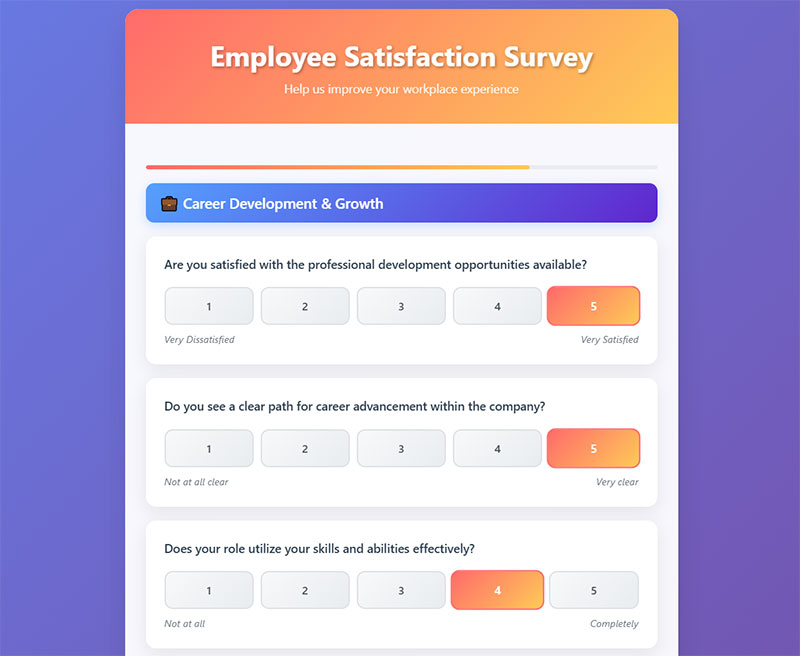
Development Opportunities
Question: Are you satisfied with the professional development opportunities available?
Type: Multiple Choice (1–5 scale from “Very Dissatisfied” to “Very Satisfied”)
Purpose: Assesses investment in employee growth and identifies learning needs.
When to Ask: During career planning discussions or annual development reviews.
Career Advancement
Question: Do you see a clear path for career advancement within the company?
Type: Multiple Choice (1–5 scale from “Not at all clear” to “Very clear”)
Purpose: Evaluates career mobility and internal promotion opportunities.
When to Ask: During performance reviews or when retention issues arise.
Skill Utilization
Question: Does your role utilize your skills and abilities effectively?
Type: Multiple Choice (1–5 scale from “Not at all” to “Completely”)
Purpose: Measures job fit and identifies underutilized talent or role misalignment.
When to Ask: During role transitions or annual skill assessments.
Training Adequacy
Question: Are you receiving adequate training to perform your job well?
Type: Multiple Choice (1–5 scale from “Very Inadequate” to “Very Adequate”)
Purpose: Identifies training gaps and ensures employees have necessary competencies.
When to Ask: After onboarding periods or when new systems or processes are implemented.
Compensation & Benefits
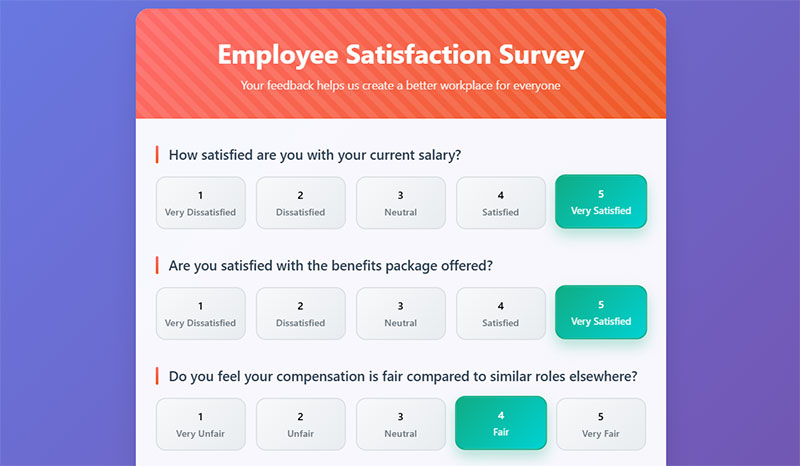
Salary Satisfaction
Question: How satisfied are you with your current salary?
Type: Multiple Choice (1–5 scale from “Very Dissatisfied” to “Very Satisfied”)
Purpose: Assesses compensation competitiveness and identifies pay equity concerns.
When to Ask: During annual compensation reviews or market analysis updates.
Benefits Package
Question: Are you satisfied with the benefits package offered?
Type: Multiple Choice (1–5 scale from “Very Dissatisfied” to “Very Satisfied”)
Purpose: Evaluates the value and relevance of employee benefits programs.
When to Ask: During benefits enrollment periods or when considering package changes.
Compensation Fairness
Question: Do you feel your compensation is fair compared to similar roles elsewhere?
Type: Multiple Choice (1–5 scale from “Very Unfair” to “Very Fair”)
Purpose: Measures perceived pay equity and market competitiveness.
When to Ask: During salary benchmarking exercises or when retention concerns arise.
Work-Life Balance
Question: How satisfied are you with your work-life balance?
Type: Multiple Choice (1–5 scale from “Very Dissatisfied” to “Very Satisfied”)
Purpose: Assesses employee wellbeing and identifies burnout risks.
When to Ask: Quarterly or during wellness program evaluations.
Resources & Support
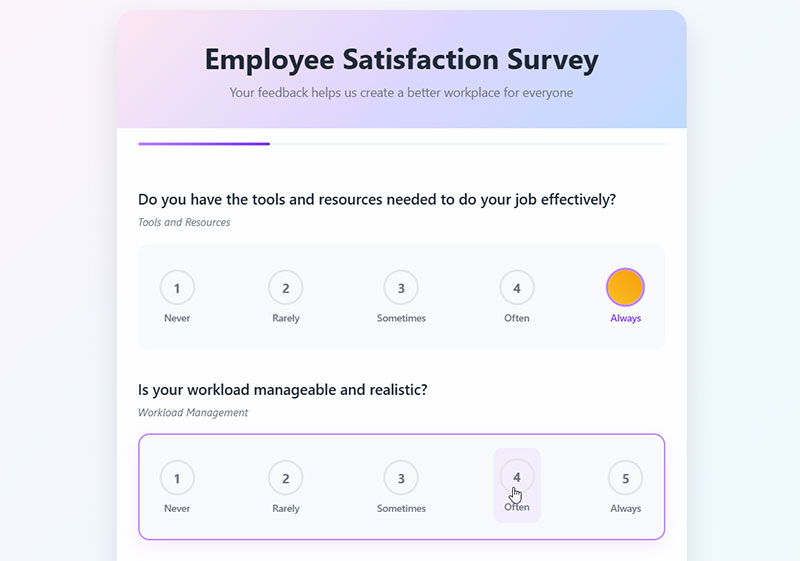
Tools and Resources
Question: Do you have the tools and resources needed to do your job effectively?
Type: Multiple Choice (1–5 scale from “Never” to “Always”)
Purpose: Identifies operational barriers and resource allocation needs.
When to Ask: During budget planning or after technology upgrades.
Workload Management
Question: Is your workload manageable and realistic?
Type: Multiple Choice (1–5 scale from “Never” to “Always”)
Purpose: Assesses capacity planning and identifies potential burnout risks.
When to Ask: During peak business periods or after organizational restructuring.
Workspace Satisfaction
Question: How satisfied are you with the physical workspace or remote work setup?
Type: Multiple Choice (1–5 scale from “Very Dissatisfied” to “Very Satisfied”)
Purpose: Evaluates environmental factors affecting productivity and comfort.
When to Ask: After office relocations, renovations, or remote work policy changes.
Recognition Programs
Question: Do you receive recognition for your contributions and achievements?
Type: Multiple Choice (1–5 scale from “Never” to “Always”)
Purpose: Measures appreciation and acknowledgment practices in the organization.
When to Ask: During performance review cycles or when implementing new recognition programs.
Communication
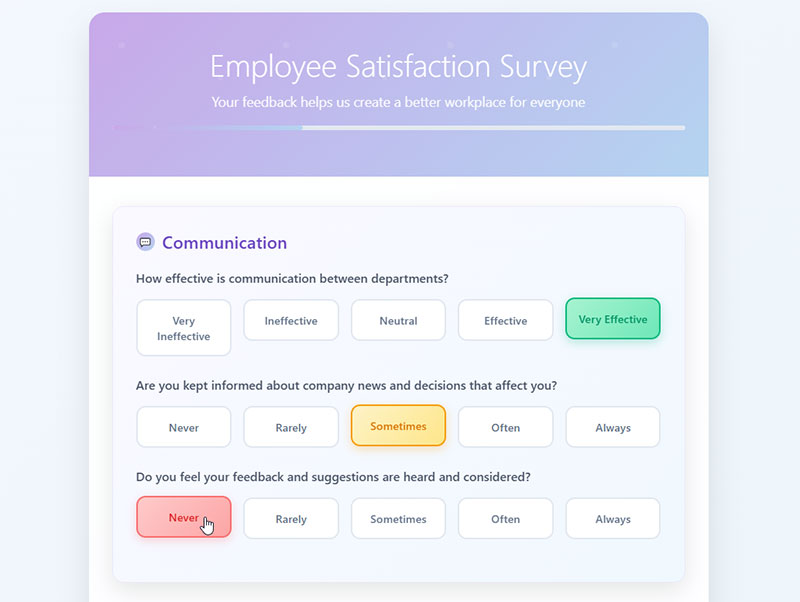
Interdepartmental Communication
Question: How effective is communication between departments?
Type: Multiple Choice (1–5 scale from “Very Ineffective” to “Very Effective”)
Purpose: Identifies silos and collaboration barriers across organizational units.
When to Ask: During cross-functional project evaluations or organizational restructuring.
Information Flow
Question: Are you kept informed about company news and decisions that affect you?
Type: Multiple Choice (1–5 scale from “Never” to “Always”)
Purpose: Assesses transparency and information sharing effectiveness.
When to Ask: After major organizational changes or during communication audits.
Feedback Reception
Question: Do you feel your feedback and suggestions are heard and considered?
Type: Multiple Choice (1–5 scale from “Never” to “Always”)
Purpose: Measures employee voice and participatory decision-making.
When to Ask: After suggestion program launches or during engagement initiatives.
Open-Ended Questions
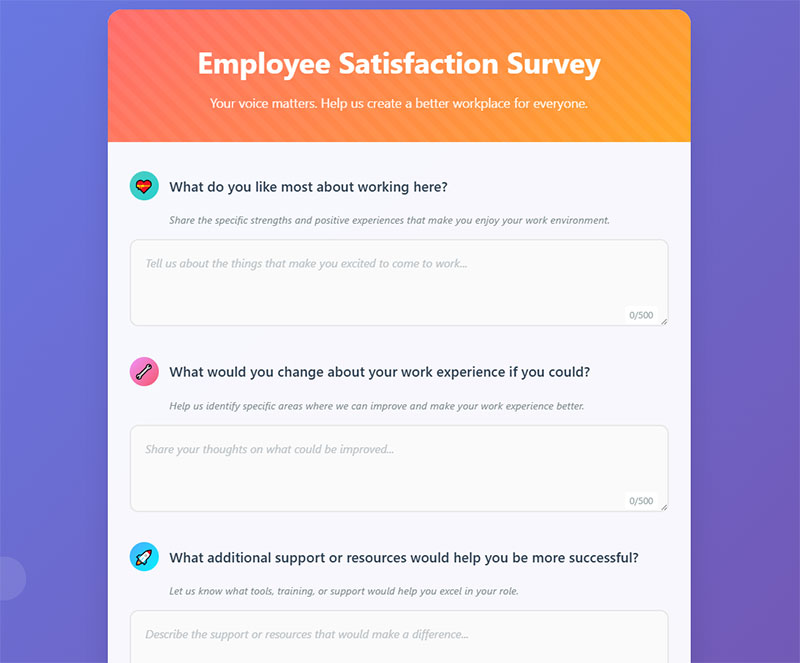
Positive Aspects
Question: What do you like most about working here?
Type: Open-ended text response
Purpose: Captures specific strengths and positive experiences to preserve and amplify.
When to Ask: In comprehensive annual surveys to balance quantitative data with qualitative insights.
Improvement Areas
Question: What would you change about your work experience if you could?
Type: Open-ended text response
Purpose: Identifies specific pain points and opportunities for organizational improvement.
When to Ask: During problem-solving initiatives or when seeking actionable feedback.
Support Needs
Question: What additional support or resources would help you be more successful?
Type: Open-ended text response
Purpose: Uncovers unmet needs and potential investments in employee success.
When to Ask: During performance planning or resource allocation discussions.
General Feedback
Question: Any other comments or suggestions for improvement?
Type: Open-ended text response
Purpose: Provides a catch-all for feedback that doesn’t fit other categories.
When to Ask: At the end of any survey to ensure comprehensive feedback collection.
FAQ on Employee Satisfaction Survey Questions
What is the ideal survey frequency for measuring employee satisfaction?
Quarterly pulse surveys work best for tracking satisfaction metrics. Annual surveys provide comprehensive workforce satisfaction survey data. Monthly micro-surveys monitor specific workplace morale indicators. Balance frequency with survey form length to avoid fatigue.
How many questions should an employee satisfaction survey include?
Effective surveys contain 20-30 questions maximum. Short pulse surveys use 5-10 questions. Include varied question types for complete workplace satisfaction assessment. Longer surveys risk lower survey response rates and incomplete data.
Should employee satisfaction surveys be anonymous?
Yes. Anonymous surveys increase honest feedback about workplace culture. Employees share authentic views on management, compensation, and workplace stress without fear. Ensure proper survey software protects identity while gathering organizational climate data.
What question types work best for satisfaction surveys?
Mix likert scale questions, multiple choice, and open-ended formats. Rating scales measure job satisfaction factors quantitatively. Types of survey questions include demographic, behavioral, and opinion-based options for comprehensive assessment.
How do you ensure high survey participation rates?
Communicate survey purpose clearly. Set reasonable deadlines. Keep survey length under 10 minutes. Mobile-friendly survey form templates boost completion rates. Share how results improve workplace benefits and employee recognition programs.
What topics should employee satisfaction surveys cover?
Essential areas include work-life balance, career development, management feedback, workplace relationships, and employee compensation. Address workplace flexibility, professional growth opportunities, and organizational commitment. Include questions about employee wellness and burnout prevention.
How often should survey questions be updated?
Review questions annually. Update based on organizational changes, workforce demographics, and industry benchmark data. Add questions reflecting current workplace satisfaction drivers. Remove outdated metrics that no longer serve employee engagement strategies.
What’s the difference between satisfaction and engagement surveys?
Satisfaction surveys measure contentment with current conditions. Employee engagement survey tools evaluate emotional commitment and productivity. Satisfaction focuses on happiness; engagement tracks motivation and organizational loyalty through different survey methodologies.
How do you analyze employee satisfaction survey results?
Use survey data analysis tools for statistical insights. Identify patterns across departments, demographics, and tenure. Compare against industry benchmarks. Focus on actionable workplace satisfaction indicators. Create visual reports showing satisfaction index trends.
What actions should follow survey results?
Share findings transparently. Develop improvement plans addressing key concerns. Implement changes to workplace culture based on feedback. Track progress through follow-up surveys. Use feedback form templates for continuous employee opinion monitoring.
Conclusion
Effective employee satisfaction survey questions transform workplace analytics into meaningful change. Organizations that prioritize regular satisfaction assessments experience improved employee retention and stronger organizational development.
Success requires more than distributing questionnaires. Your survey methodology must align with company goals while maintaining survey best practices. Consider these key factors:
- Question types that encourage honest employee feedback
- Proper timing and distribution methods
- Clear action plans based on survey reporting
- Consistent follow-through on identified issues
Remember that satisfaction measurement represents just one component of comprehensive HR management. Link survey insights to broader employee engagement strategies. Focus on creating sustainable improvements to workplace psychology and culture.
Start small with targeted pulse surveys. Build toward comprehensive annual assessments as your organization develops stronger feedback systems. The right approach to employee satisfaction evaluation drives lasting workplace transformation.


